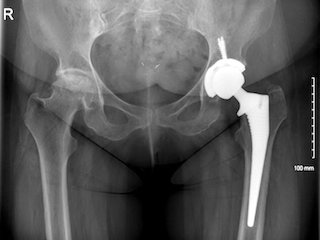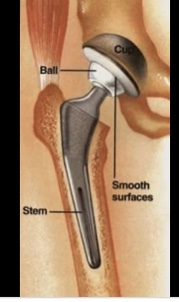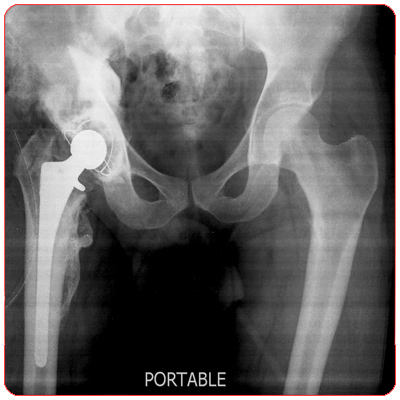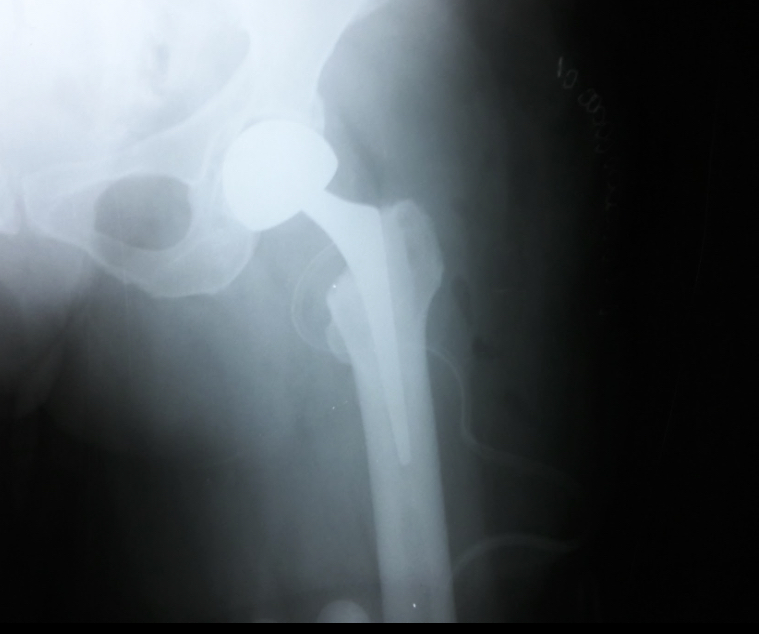Hip Replacement Surgery
 The hip joint is nothing but a ball joint with a socket. This provides a multidirectional range of movement that enables a person to sit, walk, and run. This joint gets damaged depending on the variety of causes incorporating fractures of the hip. The modern-day hip replacement surgery is quite sophisticated and more advanced. Smaller incisions do the total hip replacement surgeries.
The hip joint is nothing but a ball joint with a socket. This provides a multidirectional range of movement that enables a person to sit, walk, and run. This joint gets damaged depending on the variety of causes incorporating fractures of the hip. The modern-day hip replacement surgery is quite sophisticated and more advanced. Smaller incisions do the total hip replacement surgeries.
 Patients experience minimal pain after the surgery and soon can have as good a lifestyle as they were having before the surgery when their hip was fit and normal. Newer materials like Oxinium and Ceramic have enhanced the lifestyle expectancy of the implant, many folds. Gone are the days when young patients used to undergo a lot of pain as they were considered to be too young to be replaced. Long gone are the times when such young patients used to suffer due to a lack of long-lasting implants. Today, young patients roam all around the world after a total hip replacement.
Patients experience minimal pain after the surgery and soon can have as good a lifestyle as they were having before the surgery when their hip was fit and normal. Newer materials like Oxinium and Ceramic have enhanced the lifestyle expectancy of the implant, many folds. Gone are the days when young patients used to undergo a lot of pain as they were considered to be too young to be replaced. Long gone are the times when such young patients used to suffer due to a lack of long-lasting implants. Today, young patients roam all around the world after a total hip replacement.
 Hip Replacement In The Young Patients experience minimal pain in the post-surgery period and can have a pleasant and comfortable lifestyle. There is no restriction or any sort of boundaries for the young patients after the surgery soon after they heal through it. They are allowed to move freely and can indulge themselves in their daily activities in no time. We incorporate advanced technologies in our surgery, which enables a comfortable life after the surgery. Therefore, today, young patients can soon get their hip replacement done without having to wait for if not years than months.
Hip Replacement In The Young Patients experience minimal pain in the post-surgery period and can have a pleasant and comfortable lifestyle. There is no restriction or any sort of boundaries for the young patients after the surgery soon after they heal through it. They are allowed to move freely and can indulge themselves in their daily activities in no time. We incorporate advanced technologies in our surgery, which enables a comfortable life after the surgery. Therefore, today, young patients can soon get their hip replacement done without having to wait for if not years than months.
Hip Replacement In The Elderly In the older patients, the hip replacement happens after fracture in the hip as well as degeneration(age related and other causes). The surgery enables them to start walking again, which also encourages them to indulge in their daily life activities such as going to the washroom, being able to walk independently, and more. They are free to move on their own as early as the next day of the surgery.
 What is a Hip ReplacementThe hip is a ball and socket joint between the pelvis and the thigh bone. The upper part of the thigh is a ball-shaped part that fits into the socket in the pelvis. During the surgery, the fractured or worn-out joint is replaced with an artificial one. Hip replacement surgery is a full-fledged surgical procedure in which a prosthetic implant replaces the hip joint. The hip replacement operation can either be a total replacement or a half replacement. Such surgery is conducted to relieve the arthritic pain , to fix other physical joint damage as part of hip fracture treatment and Avascular Necrosis of hip.
What is a Hip ReplacementThe hip is a ball and socket joint between the pelvis and the thigh bone. The upper part of the thigh is a ball-shaped part that fits into the socket in the pelvis. During the surgery, the fractured or worn-out joint is replaced with an artificial one. Hip replacement surgery is a full-fledged surgical procedure in which a prosthetic implant replaces the hip joint. The hip replacement operation can either be a total replacement or a half replacement. Such surgery is conducted to relieve the arthritic pain , to fix other physical joint damage as part of hip fracture treatment and Avascular Necrosis of hip.
The total hip replacement procedure incorporates the replacement of both the acetabulum and the femoral head, while hemiarthroplasty generally only removes and replaces the femoral head. The hip replacement surgery is currently in India is the most successful as well as reliable orthopedic surgery, with 97 percent of patients reporting an enhanced and improved outcome even after 10 to 15 years.
Dr. Natt holds potential expertise in performing these surgeries. Moreover, his results have been very satisfactory.
Pre-Operation  |
Post-Operation  |
Benefits of surgery Hip replacement surgery is mostly carried out when the joint experiences severe pain that restricts mobility. The potential benefits of the surgery incorporate:
- Reduced pain
A lot of patients experience significant pain relief. It is quite normal to have temporary discomfort after the surgery. Our advanced techniques highly aim to make the operation as comfortable as possible. In most of the cases, our surgery enables patients to walk on the very next day. - Improved stiffness
The newly replaced joint incorporates a highly engineered metal as well as plastic surfaces designed to allow smooth and free movement of the joint. The motive is to prevent as much stiffness as possible after the surgery. - Increased mobility
With the amalgamation of reduced pain and improvement in stiffness, the overall movement of the patient is likely to be improved. The process helps the patient to come back to a more enhanced lifestyle actively.
Are there risks associated with a THR operation? Many operations come with a set of risks associated with it. Although there are some rare chances of risks associated with this operation, still you need to know and understand them.
Deep Vein Thrombosis (DVT) Deep Vein Thrombosis is a blood clot that happens deep into the veins of the leg, mainly to reduce the formation of a blood clot, the patient will be given a set of stockings to help with the circulation as well as medication that thins the blood. After the surgery, the physiotherapist, along with the nursing staff, will show you some potential exercises for your legs to enable smooth movement. Most patients start ambulating the next day of the surgery that further improves the circulation of blood in the legs as well as minimizes the chances of DVT.
In case clotting happens and a part of it breaks off, it can travel to your lungs, and that phenomenon is known as Pulmonary Embolus (PE). This can clash with the respiratory function, and hence we do our best to prevent DVT from developing in our patients.
Infection The chances of any infection are significantly less. Specifically saying there is about less than 1 percent of probability of an infection after the surgery. Moreover, all the potential, as well as possible precautions should be taken to prevent infection during the operation. Mostly there is a rare chance of a superficial infection that could further be treated with antibiotics.
Dislocation of the joint There is a very rare chance of displacement of the ball from the socket after the surgery. Normally we relocate the hip with a short anesthetic. In very rare cases, patients have to go through further surgery to make the hip more stable and fine.
Unequal leg length This is an infrequent and uncommon scenario that after the hip replacement, you have a difference in your leg length of a few millimeters. In a significant percentage of cases, it happens less than 1 cm and therefore is not at all noticeable. However, occasionally, you might feel your leg either a little longer or shorter. You can treat this by raising the heel of your shoes.
Hip precautions For the initial 12 weeks, proper care should be taken to prevent the hip dislocating from happening. The following points should also be considered:
- Don’t sit cross-legged and don’t cross them either while standing or lying. In the initial days or the stages of the operation, do not roll onto or lie on either side. It is highly advisable to lie on your back for the first six weeks.
- Don’t bend for more than 90 degrees at your hip. For example, avoid picking up anything off the floor, do not bend down to put your shoes on, as well as do not put your leg onto a high stool. When you sit down, ensure that your knee is on level or lower than your hip.
- Avoid twisting your hip while sitting, reaching for your thighs, or walking or changing directions.
Getting back on your feet On the very first day after the surgery, you will be shifted to the ward and will be allowed to see a physiotherapist. The therapist will teach you the early stage of your necessary exercises. They will assist you in bed and even help you to walk a few steps with the help of a walker. Over the next week, you will be taught the further essential exercises such as how to walk using appropriate aids as well as toilet training will be done on commode chair. By the time when you are about to discharge from the hospital our experienced team of physiotherapists will ensure that you achieve independence to indulge in the daily living activities such as getting up and walk around the house with the help of a walker, sitting in the chair, using the washroom, and more. In a potentially normal course, a patient is discharged home in about 5 to 6 days.
What happens after discharge from Hospital After your discharge, a member of our physiotherapy team will attend you at your place on a regular schedule to take you through all the essential exercises to enhance the range of your motion as well as the overall strength in the knee. Most patients seek the help of a walker for ambulation for about two weeks. It is highly suggested to use a high commode chair for about four weeks post-operation.
Moreover, the patient will be asked to attend the OPD after two weeks when the knee stitches will be removed, and that’s when the patient will also get the chance to see their surgeon. The further necessary medications, as well as the knee exercise instructions, will be given to the person. The person will also be encouraged to start walking with the help of a walking stick. In about 4 to 6 weeks after the hip replacement surgery, most of the people start walking independently without any walking aid.
 You also have to keep in mind that you have undergone major surgery, and hence your recovery might take about 12 months. It is necessary that you potentially follow the following guidelines when you return home:
You also have to keep in mind that you have undergone major surgery, and hence your recovery might take about 12 months. It is necessary that you potentially follow the following guidelines when you return home:
- Do not stop to take the painkillers as prescribed by the doctor. It enables you to mobilize freely and manages your pain as well as swelling.
- Take the help of a walker while ambulating. You might need a walker for about eight weeks or more.
- When it is time to stop taking your aids gradually, do so as you feel your leg getting stronger, as well as your confidence increasing. If you feel that you can walk with one stick instead of two, always use it on the opposite leg and not the one that is operated.
- Over the time, try to elevate the distance of your walking. Feel free to walk frequently throughout the day.
- It is normal to feel stiffness each morning on your operated leg. Well, you do not have to worry about this as the stiffness wears off given the time.
Frequently asked questions
- Why have I still got swelling?
The swelling of the tissue is a normal thing. The swelling only lasts for about a few months. Whenever a person takes a step, the calf muscle facilitates the blood to pump back to the heart. If you do not put all your weight on your leg, the pump will not work, and hence you get swelling around your ankle, and it happens especially at the end of the day. You might also get bruising happening in the initial first few weeks after the surgery. Therefore, this condition is normal. You are moreover advised to do your potential circulation exercises. When you rest, keep the leg raised ideally above the level of your heart, at the same time maintaining your hip precaution. - Why is my scar warm?
When the tissues are at the healing stage, they tend to produce heat. Therefore, heat can be felt on the surface for many months. - How long will I have pain?
Experiencing discomfort is likely to happen for several weeks after the surgery. Only if the pain is out of proportion, then you should immediately consult your surgeon. - Is it normal to have disturbed nights? ?
When you lie on your bed for quite a long time, your back gets stiffen up, and the discomfort then might keep you awake. This further causes a disturbed sleep pattern if you are not used to sleeping on your back. However, it is not advisable to sleep or lie on either side for the initial six weeks following your surgery. - Is it normal to have numbness around my scar?
Small nerves inside the body of the patient are disrupted during the operation, which can further cause numbness around the incision. This issue should resolve over time but might leave a small area of permanent numbness. - Why does my joint click?
The newly replaced hip works differently. The clicking, however, improves as the recovery continues. Some patients are aware of the minor clicking sound as the cartilage has been potentially replaced with plastic and metal bearings. - When can I drive?
You usually have to delay self-driving for about six weeks. Before you think of driving, you must ensure that you feel confident enough about your movement as well as strength so that you could effectively perform an emergency stop.
 Exercises You must commence the following set of exercises as soon as you can after your surgery.
Exercises You must commence the following set of exercises as soon as you can after your surgery.
Ankle exercises This exercise should be done frequently in a day for about 5 minutes or longer, if possible. This helps to maintain the circulation in your calf muscles effectively.
Deep breathing exercises This workout helps to keep your chest as clear as possible. All you have to do is take 3 or 4 deep breaths every hour.
Buttocksqueezes Effectively squeeze your glutes muscle firmly together. Hold on to this posture for about 3 seconds and relax. You should repeat the same thing for ten times for at least three times a day.
Tightening thethighmuscles? Sit or lie down with your leg straight out in front of you. Effectively point your toes towards you and tighten the front muscle of your thigh by pushing your knee down. Hold the muscle tense for about five potential seconds and then relax. Do ten sets of the same for at least three times a day.
Stairs Once you are smoothly walking without any discomfort, you will be taught how to manage stairs as well as steps. You have to take one potential step at a time.
When you have to go upstairs, use the railing on one side and a stick, on the other hand, and lead your first step with the non-operated leg. Place your foot on the step and then place the foot of your operated leg on the same step followed by your stick.
However, while going downstairs again, you have to use the railing on one side and your potential stick on the other side. Place your stick first on the step and then put forth the foot of your operated leg on the step, unlike going upstairs and then put the foot of your non-operated leg on the same step.
Post Hip 